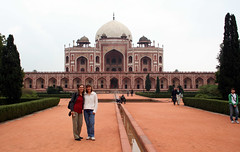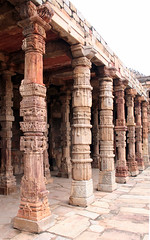
After the wedding, we spent a day in Delhi doing the tourist circuit with Caitlin. It was a gray day, but we made the best of it as our tour guide took us to one impressive sight after another. We suffered from overactive trigger fingers on the shutter, but in our defense, Delhi is steeped in fascinating layers of history, and we were skimming the cream of the crop. So here is a tiny sampling of our photo archive...
On the left, pigeons in flight at Jama Masjid, with Red Fort visible in the distance. Jama Masjid is the largest mosque in Old Delhi, while Red Fort, which we drove by, is instantly familiar to every Indian schoolchild from images of Independence Day celebrations. Red Fort was built on the banks of the Yamuna river by the Mughal emperor Shah Jahan when he moved his capital from Agra to Shahjahanabad. Our guide took pride in reciting the many names of Delhi, one for each of the emperors who founded new capitals in the area.

Emperor Humayun, son of Babar, was the first Mughal emperor born in India. His widow built a tomb for him which is now a designated World Heritage site. It is the precursor and the basic model for other, more famous sites like Fatehpur Sikri and the Taj Mahal.


Next on our list was the iconic Qutb Minar, the tallest brick minaret in the world. Qutb-ud-din Aibak, the first Muslim ruler of Delhi, started building it in 1193, but it took till 1368 to complete, using material cannibalized from previous Hindu and Jain temples in the neighborhood.

The entire Qutb Minar complex is another designated World Heritage site, and it includes not only the Qutb Minar and the famous rust-proof Iron Pillar, but also the ruins of temples with their distinctive Hindu architecture, ruins of mosques built with material recycled from those temples, and the massive base of the unfinished Alai Minar. (The Hindu figurines on the intricately carved temple walls were defaced because of the Islamic prohibition on representing faces: pillar after pillar after pillar.) The pattern of iconoclasm, destroying previous religious structures and building new ones on the ruins, has been a common theme in Indian history, and continues to be a cause (one of the many causes) of religious and ethnic conflict in India even today.
Mahatma Gandhi, who pioneered non-violent civil disobedience in India's independence movement, struggled with these religious divisions. In 1947, his dream of independence was finally achieved, but the partition of British India into India and Pakistan was, to him, an unmitigated tragedy. His vision of a self-sufficient, rural, multi-ethnic India living in religious and social harmony seems like an even more distant and utopian vision today than it was in 1947. Gandhi was shot by a radical Hindu for his "betrayal" of Hindu interests, and although he is widely revered in India, his ideals receive more honor than use. Rajghat, loosely translated as the "court of the king", is India's memorial to Gandhi. The site of his assassination is marked by a simple slab of black marble, and it is a serene and surprisingly moving place to stand and reflect on what might have been.

No comments:
Post a Comment